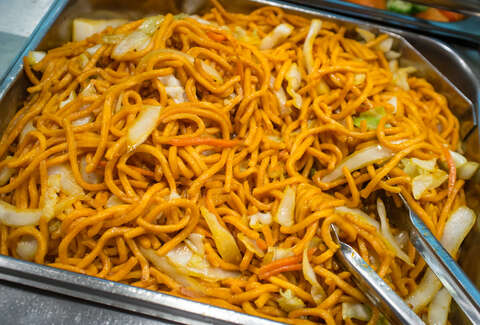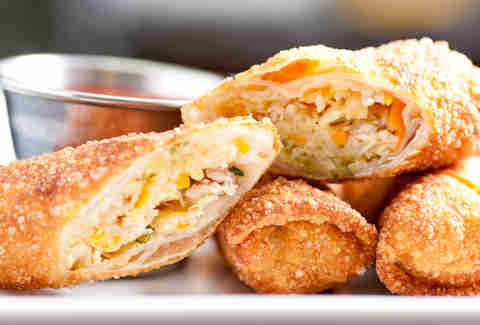
This is a great article from Thrillist. Based on the 19 things below, I’ve probably never eaten in an authentic Chinese restaurant, because of all these look incredibly familiar. So I guess the next question is, where do you actually find an authentic Chinese restaurant? Chinatown? Or do you have to literally go to China? And screw #5, I love the potstickers.
There are plenty of ethnic cuisines that America has doused in the thick, sweet sauce of appropriation, but perhaps none more so than Chinese food. There’s a time and place for things like sweet-and-sour chicken and crab rangoon, but it never feels good to be expecting a plate of mapo tofu only to get your food and realize you’ve walked into a trap set by General Tso.
To find out how to tell an authentic Chinese restaurant from an Americanized one, we called up our friends at LA’s gone-too-soon Starry Kitchen (though their funemployment has been interrupted by a cookbook/memoir deal!) and spoke with co-owner Nguyen Tran, who also shared some thoughts from his chef/wife Thi Tran. None of these are strict rules, and even a place that’s catering towards a non-Asian clientele might have a few deep-cut dishes on the menu. But if you see more than a few of these red flags, you might want to rethink what you’re putting between your chopsticks.
Sweet-and-sour sauce that’s starchy or sugary
“Sweet-and-sour is also an authentic Chinese preparation, so this is one that comes to taste. If it’s saccharine and sweet, it’s definitely an Americanized Chinese place. They do say that sugar is the secret ingredient in Chinese food, but it’s to add balance to salt or savory. It shouldn’t overpower [the other flavors]. It’s lightly salty and lightly sweet, but not like when you get a sweet tooth.
“A lot of it is prepackaged anyway, so it’s been engineered for an American palate. If it looks thick like molasses, then it’s probably Americanized. It can be made on the fly too, it’s usually just sugar, vinegar, and other ingredients poured onto the chicken. But if you need a machete to cut through it…”
Egg foo young is on the menu
“Sometimes authentic places will have this on the menu, but it’s really an American invention, and it can be disgusting. It’s like a savory pancake that’s an amalgamation of vegetables, batter, and shrimp that’s deep-fried and topped with gravy. It loses all the texture when you put gravy on it, and it just becomes mush on mush.”
Kung pao chicken is front and center
“This is actually a Chinese dish, so it kind of depends. It could be a gateway dish, but if they showcase it, more than likely it’s an Americanized Chinese place.”
You must select the protein for the fried rice
“In Americanized places there’s a generic fried-rice formula. Fried rice equals choice of protein plus fried rice. You’re ordering by protein. But with more authentic places it’s more about marrying a specific protein to a specific profile; that’s what’s unique about stir-fry. So instead of shrimp fried rice, you’d be looking for something like yeung chow fried rice.”
The use of the term potstickers
“I don’t even know where that word comes from. I couldn’t understand for years what my American friends were talking about.”
Mu shu pork
“This is another that’s actually a real Chinese dish, but it’s one that I think no Asian has ever eaten in their life.”
Crab rangoon
“You’re not going to see that. I don’t think I’ve ever seen sour cream in any dish in a real Chinese restaurant.”

Egg roll-and-soup lunch special
“This is a sweeping generalization, but many authentic Chinese restaurants don’t even have egg rolls on the menu. This is my bias, but Chinese egg rolls are some of the worst egg rolls I’ve ever had in my life. These are the Americanized ones. It’s all cabbage, wrapped in a really crappy wrapper, it’s fat, and you’re dipping it in sweet-and-sour.”
A giant container of soy sauce on the table
“A lot of people just add soy sauce to everything they eat. You should try the food first; soy sauce is the equivalent of salt. That’s the exact reason it’s there. If there’s a huge bottle or it looks like it’s replenished a lot, that might be a sign. You might not even see it that often at an authentic restaurant.”
Metal American spoons
“If they have metal Western spoons versus Asian soup spoons, it’s more than likely an Americanized Chinese restaurant. Most real Asian places don’t see the need for both. It’s subtle, and people might argue this to death, but if you ask for a spoon, I’ll hand you a soup spoon.”

Everything comes with an individual side of rice
“Asian food is usually eaten family-style, but at Americanized places the rice is more likely to be individually portioned. So if it’s served individually right in front of you versus in the middle of the table, that’s a tell.”
American desserts
“If there’s an American dessert or a fried wonton with honey and powdered sugar, that’s not an authentic Chinese restaurant at all.”
There aren’t any Asian people eating there
“If the only Asian people in the restaurant are working there, that’s always a sign of it not being an authentic Chinese restaurant.”

The tri-fold door menu
“If it looks like something that could be a mailer, or be put on your door, then it’s more than likely a totally Americanized place.”
Pictures of Americanized items on the menu
“This has moved into Asian culture, but if you see a picture of kung paochicken at the front, it’s definitely a fake place.”
The sign/menu uses a stereotypically Asian font
“That font can get people riled up. It’s so embedded in our culture from the early days of America, with the Chinese working on the railroads and stuff. It instills in someone who’s not Asian that, ‘Wow, this must be Asian food.’ Visually it does trigger that. It’s funny because in Santa Barbara the street signs have this font. My wife gets worked up about it!”

Bags filled with stacks of to-go orders
“If there’s a side table with all these bags tied up at the top with containers, or with the Chinese folding box with the handles… if you see that ready to go, it’s more than likely to be fake. What’s more Americanized than Chinese takeout?”
Empty fish tanks
“If they have big fish tanks that are empty, it might be an Americanized restaurant. Live seafood is a big part of authentic Chinese food, so an empty fish tank shows that they might’ve evolved into being more Americanized over time because the seafood was too expensive.”
There are dragons everywhere
“It’s not offensive at all, but it’s probably an Americanized place. It goes with things like latticework and a big circular doorway. Current Chinese culture is pretty modernized, so it’s weird if you’re literally entering the dragon.”
Crabtree@yellowstoneresearch.org Rangoon is made with cream cheese, not mayonnaise. Both disgusting of course. And why is a Vietnamese couple advising on the authenticity of American pseudo-Chinese restaurants anyway?